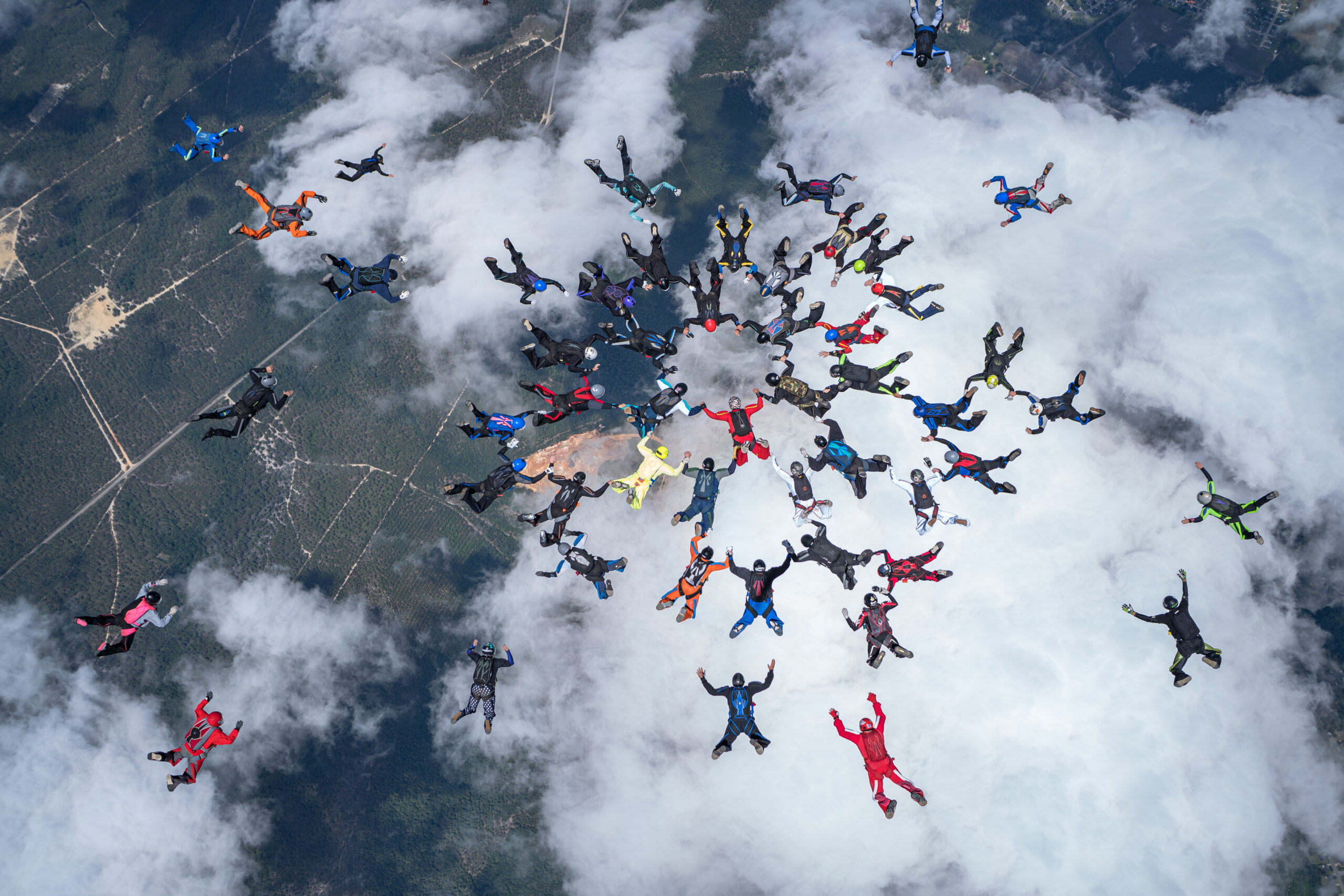Sport Skydiving and Its Competitive Disciplines
Tuesday, February 28, 2023
- Team FlyXP
- 2/28/23
- 0
- Skydiving
So, you did a tandem skydive, and it was out-of-this-world amazing. You definitely want more … but what does that mean for you? Remember all those people you saw making solo skydives when you were at the dropzone? They have their skydiving license and are known as fun jumpers or sport jumpers. Yep, skydiving is considered a sport and, like other sports, there are competitions.
What’s more, there are a number of different disciplines and competitions for aerial athletes – the world of skydiving sports is just as diverse as the people who participate in them. Jumpers can specialize in every single part of the skydive, from freefall to landing. When it comes to competition skydiving, the sky’s the limit, literally!
Is sport skydiving in your future? What about competitive skydiving? Here’s a peek into the most popular skydiving disciplines.
Formation Skydiving
The most well known type of skydiving competition is called formation skydiving. This is what people automatically picture when they think of a group of skydivers – four or eight people holding hands in different configurations. Sometimes, the groups can be even bigger if they are going for a new record. Record attempts can include hundreds of jumpers!
The most traditional version of formation skydiving is called relative work, or RW for short. In this discipline, skydivers fall in a standard arch position with their bellies facing the earth. This is the position you use when you are doing a tandem and is the first thing all skydivers learn to do.
These groups of four or eight skydivers will then complete a series of intricate formations by holding onto the grips on each other’s jumpsuits. These holds are called points and the competitions are usually judged by how many points are completed and how well the formations are executed.

Vertical Formation Skydiving
As flying styles have changed, so have competition opportunities. More and more people are starting to participate in freeflying, which is flying with their heads up or down instead of on their bellies. Combining formation skydiving with freeflying has yielded vertical formation skydiving.
Vertical formation skydiving looks a lot like RW, but in different positions. The skydivers who compete in vertical formation skydiving complete formations and points the same way RW skydivers do, but while freeflying. While RW formations spread out horizontally, vertical formation skydives can build horizontally or vertically. This is thanks to the fact that the people on the skydive can build formations that assemble like stacks because they are flying head up or head down.
Formation skydiving is one of the oldest disciplines in the sport and continues to evolve right along with the sport!
Freestyle
Freestyle skydiving is exactly what it sounds like – dealer’s choice! This discipline is very much like sky dancing. Freestyle teams are made up of two skydivers, one who “performs” and one who captures the jump on video.
Both vertical and horizontal flying are used in freestyle, and the direction and speed of the skydive can change rapidly. This means that the person flying video must be a very skilled flyer and both members of the team have to be on the same page at all times.
Because freestyle is an open form of expression and, therefore, subjective, there are rules in place to ensure judging is fair and accurate. Every freestyle team must compete in both free routines and compulsory rounds. The free routine is choreographed by the team, and the compulsory round includes moves set by the competition. Freestyle teams are judged on style, skill, and creativity.
Wingsuiting
Ah yes, wingsuiting, a fan favorite. Wingsuits are not able to build formations the same way that formation skydvers can, so, wingsuit competition has evolved to accommodate the unique needs of wingsuit flyers. There are two types of competition wingsuiting: acrobatics and performance.
Acrobatic competition looks a lot like freestyle skydiving, but with more fabric. In acro, a team of two wingsuiters performs highly choreographed routines to score points based off of creativity, skill, and execution. And there’s a lot more forward movement! Wingsuits can cover upwards of a mile in a single flight!
Performance competition is much more focused on what an individual pilot can achieve on the technical side of things. Three rounds of GPS judging are used to determine the wingsuiters maximum speed, maximum distance, and maximum flight time. Each round is dedicated to one of the three skills, and the scores are compiled at the end to determine the winner.

Canopy Piloting
Some skydivers are all about their parachute! There are as many different disciplines of canopy competition as there are freefall ones, and each discipline is equally unique. Most of the canopy disciplines echo the themes that we see in freefall competition.
Perhaps the most viewer-accessible discipline in all of skydiving is swooping. Swooping involves a skydiver executing a series of turns that increases the speed of their parachute as they approach the ground. They then flatten out their parachute to glide across the ground at around 70 mph!
Swooping is judged in different categories including speed, distance, and accuracy. And like the other skydiving competition disciplines, swooping includes a freestyle category as well. In freestyle, swoopers will complete a series of tricks as they skim over a pond or the ground before touching down.
Canopy pilots also have their own version of formation skydiving. This discipline is known as canopy relative work, or CRW (pronounced “crew”), and involves a group of two to four parachutes coming together to form shapes in the sky. CRW parachutists will link to each other using their feet and the lines of the canopy to make formations that resemble diamonds, stacks, or pretty much any shape they can imagine!
Canopy piloting actually boasts the oldest form of skydiving competition in the sport. Canopy accuracy involves either a single jumper or a team of four landing as close to a target as possible. For the pros, the target is about the size of a penny and the difference between 1st and 2nd place can come down to mere milimeters!
How to Get Started
Come watch a competition! Even being on the ground during a skydiving competition is exciting, and experiencing the energy of the athletes is intoxicating! You don’t have to be a skydiver to enjoy skydiving competitions.
But if you are interested in becoming a high flying athlete, the first step is to get your skydiving license. Once you complete your tandem skydives, enroll in our student program and start learning to skydive! Our instructors will teach you everything you need to know to be a successful skydiver. From there, you can start specializing in your discipline of choice!
Jumping out of an airplane not for you? People actually compete in indoor skydiving, too!
We can’t wait to introduce you to our diverse world! Book here to jump today!
Copyright © 2025, Skydive Paraclete XP, All Rights Reserved.
DropZone Web Design & Marketing by Beyond Marketing, LLC
